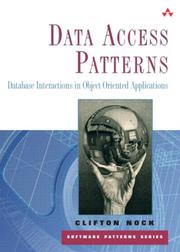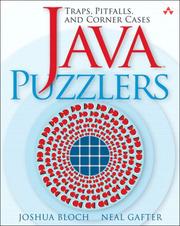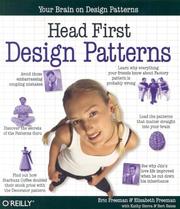| Listing 1 - 9 of 9 |
Sort by
|
Multi
ISBN: 9781484290606 9781484290590 9781484290613 Year: 2023 Publisher: Berkeley, CA Apress :Imprint: Apress
Abstract | Keywords | Export | Availability | Bookmark
 Loading...
Loading...Choose an application
- Reference Manager
- EndNote
- RefWorks (Direct export to RefWorks)
As a programming language, Java's object-oriented nature is key to creating powerful, reusable code and applications that are easy to maintain and extend. That being said, many people learn Java syntax without truly understanding its object-oriented roots, setting them up to fail to harness all of the power of Java. This book is your key to learning both! This new third edition of Beginning Java Objects: From Concepts to Code discusses Java syntax, object principles, and how to properly structure the requirements of an application around an object architecture. It is unique in that it uses a single case study of a Student Registration System throughout the book, carrying the reader from object concepts, to object modeling, to building actual code for a full-blown application. A new chapter covers a technology-neutral discussion of the principles of building a three-tier architecture using Java, introducing the notion of model layer – presentation layer – data layer separation. Coding examples used throughout the book are Java version-neutral. The core object-oriented principles that you will learn from this book are timeless, and are relevant to all versions of the Java language, as well as to many other object-oriented languages. The book can be used for individual self-study or as a university-level textbook. What You Will Learn Know basic object-oriented principles, from the simplest notion of classes and objects through the power of encapsulation, abstract classes, and polymorphism Approach the requirements for an application to structure it properly around objects Render the resultant object model into Java code, building a complete functioning model layer for the Student Registration System case study Conceptually round out an object layer by adding presentation and data layers .
Book
ISBN: 9789043020558 9043020559 Year: 2011 Publisher: Pearson Education Benelux
Abstract | Keywords | Export | Availability | Bookmark
 Loading...
Loading...Choose an application
- Reference Manager
- EndNote
- RefWorks (Direct export to RefWorks)
Praktisch UML is een handleiding voor het toepassen van de Unified Modeling Language (UML), de standaard voor objectgeoriënteerde analyse en ontwerp, die sinds 1997 wereldwijd wordt gebruikt. Deze vijfde editie van Praktisch UML biedt: - een beschrijving van de belangrijkste objectgeoriënteerde principes; - een beschrijving van de diverse UML-diagrammen; - inzicht in de samenhang tussen de UML-diagrammen; - een overzicht van de notatie van de UML-diagrammen; - een beschrijving van de Object Constraint Language; - een complete werkwijze waarmee de diagrammen ontwikkeld kunnen worden; - een nieuwe doorlopende case ter illustratie van deze werkwijze; - een uitgebreidere website met oefenmateriaal dat aansluit bij de behandelde stof: www.pearsoneducation.nl/warmer. Praktisch UML is bedoeld voor iedereen die betrokken is bij objectgeoriënteerde systeemontwikkeling. Het ken dienen als introductie tot UML of als naslagwerk voor studenten en professionele automatiseerders.
Object-oriented programming --- 681.33 --- 681.35 --- UML --- 681.3*D15 --- 681.3 --- Programmeertalen : UML --- 681.3*D15 Software: object-oriented programming --- Software: object-oriented programming --- Programmering --- Computerarchitectuur. Operating systems --- Programming --- UML (unified modeling language) --- object oriented analysis --- Computer architecture. Operating systems --- PXL-IT 2014 --- informatica --- UML - Unified Modeling Language --- Objectgeoriënteerd programmeren --- 004.4 --- Unified Modeling Language
Book
ISBN: 9781435455009 1435455002 Year: 2010 Publisher: Boston, MA : Course Technology Cengage Learning,
Abstract | Keywords | Export | Availability | Bookmark
 Loading...
Loading...Choose an application
- Reference Manager
- EndNote
- RefWorks (Direct export to RefWorks)
Python (Computer program language) --- Object-oriented programming (Computer science) --- Python (Langage de programmation) --- Programmation orientée objet (Informatique) --- Programmation orientée objet (Informatique) --- Programming --- programmeren (informatica) --- Python (informatica)
Multi
ISBN: 9783658398293 9783658398286 9783658398309 Year: 2023 Publisher: Wiesbaden Springer Fachmedien Wiesbaden :Imprint: Springer Vieweg
Abstract | Keywords | Export | Availability | Bookmark
 Loading...
Loading...Choose an application
- Reference Manager
- EndNote
- RefWorks (Direct export to RefWorks)
A practical description of the software design patterns as they are mentioned in the 1994 book "Design Patterns - Elements of Reusable Object Oriented Software" by the author group Gamma, Helm, Johnson and Vlissides (also called "Gang of Four"). All patterns are explained in detail by means of examples and also critically appreciated. Furthermore, design principles of object-oriented programming are described and considered. All examples are commented in detail in the source code and are executable under Java 16. In some cases, newer features of Java up to and including version 16 are also explained and used. The contents - What are design patterns - How to describe them - Object-oriented design principles - All 23 original design patterns of the "Gang of Four" - Combining design patterns The target audience - Pupils, trainees and students of computer science - Programming beginners after the first steps in Java The author Olaf Musch is a computer scientist, has developed software himself for many years and now works as a project manager in the IT department of a large company in Lower Saxony. This book is a translation of an original German edition. The translation was done with the help of artificial intelligence (machine translation by the service DeepL.com). A subsequent human revision was done primarily in terms of content, so that the book will read stylistically differently from a conventional translation.

ISBN: 0131401572 Year: 2004 Publisher: Boston Addison-Wesley
Abstract | Keywords | Export | Availability | Bookmark
 Loading...
Loading...Choose an application
- Reference Manager
- EndNote
- RefWorks (Direct export to RefWorks)
Programming --- programmeren (informatica) --- database management --- object oriented --- 681.3*D2 --- 681.3*D15 --- 681.3*D15 Software: object-oriented programming --- Software: object-oriented programming --- 681.3*D2 Software engineering: protection mechanisms; standards--See also {681.3*K63}; {681.3*K51} --- Software engineering: protection mechanisms; standards--See also {681.3*K63}; {681.3*K51}

ISBN: 032133678X 9780321336781 Year: 2005 Publisher: Upper Saddle River Addison-Wesley
Abstract | Keywords | Export | Availability | Bookmark
 Loading...
Loading...Choose an application
- Reference Manager
- EndNote
- RefWorks (Direct export to RefWorks)
Programming --- Java (informatica) --- Computer architecture. Operating systems --- Tools and techniques: decision tables; flow charts; modules and interfaces; programmer workbench; software libraries; structured programming; top-down programming; user interfaces (Software engineering) --- 681.3*D22 Tools and techniques: decision tables; flow charts; modules and interfaces; programmer workbench; software libraries; structured programming; top-down programming; user interfaces (Software engineering) --- Java (Computer program language) --- 005.133 --- 681.3*D15 --- 681.3*D22 --- 681.3*D3 --- 681.3*D15 Software: object-oriented programming --- Software: object-oriented programming --- 681.3*D3 Programming languages --- Programming languages --- Object-oriented programming languages --- JavaSpaces technology
Multi
ISBN: 9781430218609 9781430217497 9781430218593 1430218592 Year: 2010 Publisher: Berkeley, CA Apress
Abstract | Keywords | Export | Availability | Bookmark
 Loading...
Loading...Choose an application
- Reference Manager
- EndNote
- RefWorks (Direct export to RefWorks)
The Cocoa frameworks are some of the most powerful frameworks for creating native desktop applications available on any platform today, and Apple gives them away, along with the Xcode development environment, for free! However, for a first-time Mac developer, just firing up Xcode and starting to browse the documentation can be a daunting task. The Objective-C class reference documentation alone would fill thousands of printed pages, not to mention all the other tutorials and guides included with Xcode. Where do you start? Which classes are you going to need to use? How do you use Xcode and the rest of the tools? This book answers these questions and more, helping you find your way through the jungle of classes, tools, and new concepts so that you can get started on the next great Mac OS X application today. Jack Nutting is your guide through this forest; he's lived here for years, and he'll show you which boulder to push, which vine to chop, and which stream to float across in order to make it through. You will learn not only how to use the components of this rich framework, but also which of them fit together, and why. Jack Nutting's approach, combining pragmatic problem-solving with a deep respect for the underlying design philosophies contained within Cocoa, stems from years of experience using these frameworks. He'll show you which parts of your application require you to jump in and code a solution, and which parts are best served by letting Cocoa take you where it wants you to go. The path over what looks like a mountain of components and APIs has never been more thoroughly prepared for your travels. With Jack's guidance, the steep learning curve becomes a pleasurable adventure. There is still much work for the uninitiated, but by the time you're done, you will be well on your way to becoming a Cocoa master.
Programming --- Computer architecture. Operating systems --- Computer. Automation --- computers --- computerbesturingssystemen --- programmeren (informatica) --- software engineering --- OS (operating system) --- computerkunde --- Apple --- Application program interfaces (Computer software). --- C (Computer program language). --- Cocoa (Application development environment). --- Object-oriented programming (Computer science). --- Mac OS.
Book
ISBN: 9043008125 Year: 2004 Publisher: S.l. Pearson Addison Wesley
Abstract | Keywords | Export | Availability | Bookmark
 Loading...
Loading...Choose an application
- Reference Manager
- EndNote
- RefWorks (Direct export to RefWorks)
0-0812-5
Programming --- UML (unified modeling language) --- object oriented analysis --- Computer architecture. Operating systems --- systeemontwikkeling --- 681.3*D2 --- Internet --- object-oriented programming --- 681.3* / / / / / / / / / / / / / / / / / / / / / / / / / / / / --- uml --- 681.3*D2 Software engineering: protection mechanisms; standards--See also {681.3*K63}; {681.3*K51} --- Software engineering: protection mechanisms; standards--See also {681.3*K63}; {681.3*K51} --- Computer science --- Databanken --- UML --- Databank --- Unified Modeling Language

ISBN: 9780596007126 0596007124 Year: 2014 Publisher: California O'Reilly Media
Abstract | Keywords | Export | Availability | Bookmark
 Loading...
Loading...Choose an application
- Reference Manager
- EndNote
- RefWorks (Direct export to RefWorks)
1 Welcome to design patterns : an introduction 2 Keeping your objects in the know : the observer pattern 3 Decorating objects : the decorator pattern 4 Baking with OO goodness : the factory pattern 5 One of a kind objects : the Singleton pattern 6 Encapsulating invocation : the command pattern 7 Being adaptive : the adapter and facade patterns 8 Encapsulating algorithms : the template method pattern 9 Well-managed collections : the iterator and composite patterns 10 The state of things : the state pattern 11 Controlling object access : the proxy pattern 12 Patterns of patterns : compound patterns 13 Patterns in the real world : better living with patterns 14 App. : leftover patterns
Computer software --- Java (Computer program language) --- Development. --- Development --- Ontwerpmethodologie. --- Programmeermethoden. --- Programming --- Artificial intelligence. Robotics. Simulation. Graphics --- vormgeving --- java --- 681.3.06 --- Java --- Softwareontwikkeling --- Systeemanalyse (Systeemontwerp) --- softwareontwikkeling --- 681.3 --- Software-ontwerp --- Ontwerppatronen --- 654 --- AA / International- internationaal --- Development of computer software --- Software development --- Object-oriented programming languages --- JavaSpaces technology --- Informatieverwerking. Bureautica --- Logiciels --- Java (Langage de programmation) --- Développement --- Programmering --- Artificiële intelligentie. Robotica. Simulatie. Graphics --- Design Patterns --- Programmeren --- PXL-IT 2019 --- PXL-Handboeken --- programmeren --- designconcept --- Informatica --- Softwarepakketten --- Systeemontwikkeling --- Softwareontwikkelmethode --- Kind --- Computer software - Development. --- Computer software - Development
| Listing 1 - 9 of 9 |
Sort by
|

 Search
Search Feedback
Feedback About UniCat
About UniCat  Help
Help News
News